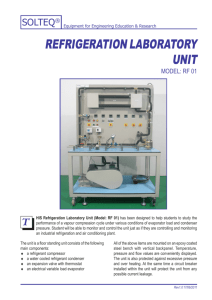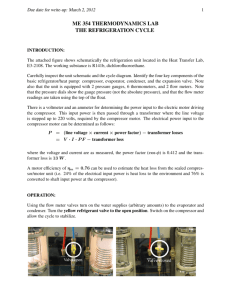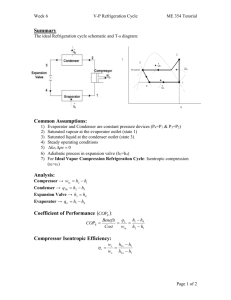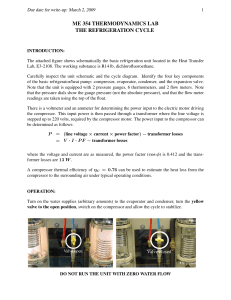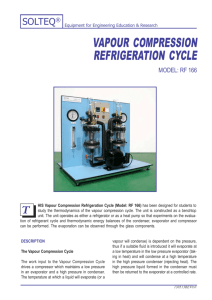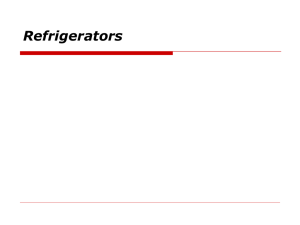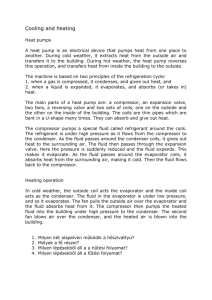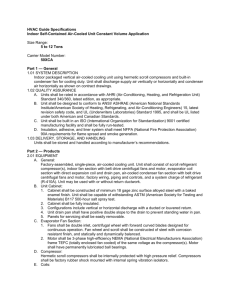REFRIGERATION AND AIR CONDITIONING
advertisement
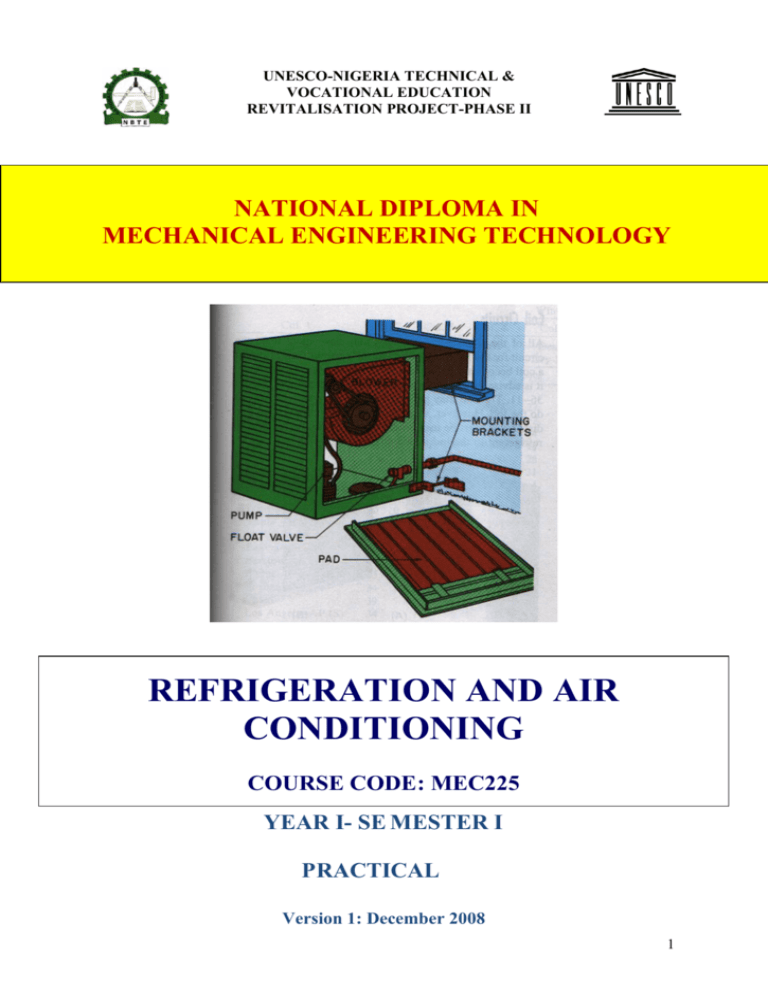
UNESCO-NIGERIA TECHNICAL &
VOCATIONAL EDUCATION
REVITALISATION PROJECT-PHASE II
NATIONAL DIPLOMA IN
MECHANICAL ENGINEERING TECHNOLOGY
REFRIGERATION AND AIR
CONDITIONING
COURSE CODE: MEC225
YEAR I- SE MESTER I
PRACTICAL
Version 1: December 2008
1
Table of Contents
Week 1:
To assess the mechanism of cold state production
Week 2:
To determine pressure-temperature relationship using refrigerator
Week 3:
To identify and sketch various components of vapour compression refrigeration
system.
Week 4:
Measurement of properties of air
Week 5:
To determine the coefficient of performance of the Air-conditioning test unit
Week 6:
Measurement of heat transfer rate and estimation of coefficient of performance of a
vapour compression refrigeration cycle.
Week 7:
Measurement of heat transfer rate and estimation of coefficient of performance of a
vapour compression refrigeration cycle
Week 8:
To determine the coefficient of performance of the Air-conditioning test unit
Week 9:
To determine the coefficient of performance of the Air-conditioning test unit
Week 10:
TROUBLE SHOOTING: Self-contained Mechanical Refrigerators
Week 11:
TROBLE SHOOTING: Air handling Units - General
Week 12:
TROBLE SHOOTING: Thermostatic Expansion Valves
Week 13:
TROBLE SHOOTING: Chilled-Water Air handling Units
Week 14:
TROBLE SHOOTING: Air handling Units - Electric Heating Coils
Week 15:
TROBLE SHOOTING: Condensing Units (General)
Week one
Title: Cold State concepts.
Aim: To assess the mechanism of cold state production.
Apparatus:
Conical flask, methylated spirit, trough, thermometer.
Method:
Pour a small quantity of methylated spirit into your palm and allow to vapourise.
Note your feeling on your palm.
Now pour a given quantity of the methylated spirit into a conical flask or beaker.
Pour water in a trough and measure the temperature or
Feel the coldness of the water
Place the conical flask with the content into the water in the rough until all the
spirit vapourises.
Feel the measure the new temperature of water in the trough.
Observations: Note your observation.
Discussion:
Discuss this test and the phenomenon of vapourisation associated with the cold
state achievement
Title:
Concept of cold making
Aim:
To show the direction of heat flow
Apparatus:
Beaker, ice blocks, thermometer stirrer.
Method:
Pour water into a beaker half full.
Measure the temperature of the water and record.
Add some cubes of ice blocks into the water.
Stir the mixture gradually or shake the mixture for a period of three minutes.
Measure the temperature of the mixture.
Record the new temperature
Observation: Note your observations.
Discussion:
Discuss this phenomenon
Title:
Concept of cold making
Aim:
To measure the quantity of heat transfer between two bodies at different
temperatures.
Apparatus:
Conical flask or beaker, ice blocks, water, thermometer.
Method:
Weigh the flask or beaker.
Add a quantity of water, weigh the beaker and water and record.
Measure the initial temperature of water and record.
Add a known mass of ice blocks and stir together until all the ice blocks melt.
Take the thermometer reading of the final temperature of the mixture and record.
Observations/
Result:
Record all the measurements of mass and temperature.
Calculation:
Calculate the quantity of heat transfer from water to ice blocks.
Discussion:
Discuss this test and state the quantity of heat transfer.
Title:
Concept of cold making
Aim:
To show the effect of pressure on temperature.
Apparatus:
(i) Ice block measuring 150 x 75 x 75mm
(ii) A length of string of 500mm
(iii) Weighing hangers 2no.
(iv) A set of weights
(v) Stool
Method:
Place the ice bock on the stool.
Attach the string to the weighing hanger.
Place the string over the ice block.
Add some equal weighs in the weighing hangers.
Allow the assembly to stay for 10 minutes.
Repeat this with different weights.
Observation: Note your observation on the interration between string and ice block.
Discuss:
Discuss this test.
WEEK 2
TITLE:
To determine pressure-temperature relationship using refrigerator II
APPARATUS:
Refrigerator demonstration unit, thermometers, water (cool and
warm)
THEORY:
RII is a refrigerator with chemical name, tichloroflouromethane, and formula, cd3F.
The boiling point is 23.80C (74.90F). At – 150C (50F) suction and 300C (860F)
condensing temperatures, the following parameters are obtained:
Condensing pressure
3.5psig
hy per ITR
0.94
cmf per ITR
36.54
COP
5.03
The colour code for RII is orange and the UL hazard class is 5a. The
refrigerant has a faint, non-flamable and a low pressure refrigerant used mainly in
large low speed centrifuges. It is an excellent solvent much used to wash out
systems contaminated by motor burnants. It is supplied in low pressure drums or
cylinders pressurized with nitrogen as a propellant.
The full physical properties of refrigerants can only be detailed in extensive
and complicated tables and charts which are not easy to understand. Exhaustive
details are not however important to the installation or service engineer or
technician whose needs are concentrated on converting gauge pressures into
temperature or into gauge pressures of each of the refrigerants with which he
works.
Simple temperature to pressure relationships are detailed in the attached
table. The table being the temperature/pressure relationships for various refrigerant
and is straight forward in its practical application. If the installation technician is
balancing an R12 system to run at a saturated temperature of -290C (-200F), he
aims at a gauge reading of 0.6psig. if his discharge gauge reading is 136.4psig, the
table will tell him that the condensing temperature is 43.30C (1100F).
PROCEDURE
1. Charge the refrigerant into the system and allow to reach the desired
quantity.
2. Condition the evaporator and condenser to work at the same temperature by
allowing warm water into the evaporator and cool water into the condenser.
3. When an equilibrium temperature is reached, vary the water flow rate and
record the observed corresponding temperature and pressure.
4. Tabulate the results obtained from the experiment over a practical range and
plot the graph of pressure-temperature relationship.
PRECAUTION
State the necessary precautions taken in the course of carrying out the experiment.
RESULTS/OBSERVATION/GRAPHS:
Tabulate the results obtained and state any unique observation made during the
experiment. Present your results in graphical form and briefly interpret or analyze
it.
RECOMMENDATION AND CONCLUSION
State the reference of this test and highlight specific industrial application of this
test. How can this be used to explain the characteristics and effects of using one
refrigerator in place of another for a domestic refrigerator or window air
conditioner.
Week 3
Title:
Refrigeration components
Aim:
To identify and sketch various components of vapour compression refrigeration
system.
Method:
Pick from the numerous components, provided, sketch, label and briefly describe
each of them.
Discussion:
Discuss the function of each of the components/parts sketched.
WEEK 4
TITLE:
Measurement of properties of air
OBJECT: To determine the relative humidity, humidity ratio, vapor density,
degree of saturation, enthalpy, and dew-point temperature of air by the
use of a sling psychrometer and a psychrometric chart.
APPARATUS:
Sling psychrometer or stationary-bulb psychrometer, mercurial
barometer, psychrometric chart.
Drawing
THEORY:
Liquids, vapours, and gases occur in a great variety of mixtures in fuels, products
of combustion, refrigeration systems, steam boilers, and condensers and in
atmospheric air. Mixtures of air and steam are by far the most common of the gasvapour mixtures. Steam boilers deliver steam containing small amounts of air, and
when this steam is condensed, the problem of air removal arises. Steam turbines,
condensers, and evaporators that operate below atmospheric pressure will admit air
through any leakage areas, and this air must be removed. Since most fuels contain
5 to 25 per cent of hydrogen, products of combustion in furnaces and engines are
gas-steam mixtures. Water cooling by evaporation in air requires the computation
of air-steam mixtures in spray ponds, cooling towers, evaporative condensers for
refrigeration, etc. Humidification and dehumidification of air I all phases of air
conditioning require a variety of computation procedures of air-steam mixtures.
Since humidity affects the behavior of so many commercial materials such as
wood, paper, textiles, paint, tobacco, pastes, and doughs, the control of
atmospheric moisture is a major problem in industrial as well as home air
conditioning. Because air and low-pressure steam behave approximately as ideal
gases, the perfect-gas laws form the basis for most calculations. The ratio of the
constituents of the air-steam mixture may be expressed in either weight or volume.
METHOD:
The accuracy of the wet and dry-bulb thermometers should be noted before the
wick is moistened by reading both thermometers in an air stream when dry. No
difference in reading should be visible in a good instrument. Moisten the wet-bulb
wicking and whirl at about 150 rpm; then read wet bulb first. Whirl, read, whirl,
read until the lowest possible wet-bulb reading is obtained. Use clean water;
distilled water is preferred. Do not touch the wet bulb, as the slightest oily deposit
on the wicking will cause errors. Read mercurial barometer.
CONCLUSION
1. How did you get the relative humidity of the air? The humidity ratio, the
vapor density, the degree of saturation, the enthalpy, and the dew-point
temperatures?
2. What temperature is a measure of sensible heat, total heat and moisture
content?
i.
The psychrometry is the branch of engineering science that deal with the
study of Moisture air. Moisture air consists of dry air mixed with water
vapour or humidity. It also includes the study of behaviour of dry air and
water vapour mixture under various conditions.
ii.
The earth’s atmosphere is a mixture of gases including nitrogen (N 2),
oxygen (O2), argon (Ar), and carbon dioxide (CO2); yet for the purpose of
psychrometry, it is considered to be a mixture of dry air and water vapour
only.
iii.
The dew point temperature is the temperature of air recorded by a
thermometer, when the moisture 9water vapour) present in it begins to
condenser. In other words, the dew point temperature is the saturation
temperature (tsat) corresponding to the partial pressure of water vapour (P v),
it is usually denoted by tdp.
Since PV is very small, therefore the saturation temperature by water vapour at PV
is also low (less than atmospheric or dry bulb temperature).
This is water vapour in air exists in the superheated state and the moisture air
containing moisture in such a form (i.e. in the superheated state) is said to be
unsaturated air.
This condition is shown by point A on T-S chart as shown below. When the partial
pressure of water vapour (PV) is equal to the saturation pressure (PS); the water
vapour is in dry condition and the air will be saturated air.
If a sample unsaturated air containing superheated water vapour is cooled at
constant pressure, the partial pressure (PV) of each constituent remains constant
until the water vapour reaches the saturation state as in point B. at this point B the
first drop of dew will be forward and hence the temperature at point B is called
dew point temperature. Further cooling will cause condensation of water vapour.
From the above illustration, the dew point temperature is the temperature at which
the water vapour begins to condenser.
Dry bulb temperature is the temperature of air recorded by a thermometer
when it is not affected by the moisture present in the air (td or tdb)
Wet bulb temperature is the temperature of air recorded by thermometer
when its bulb is surrounded by a wet cloth exposed to air.
Psychrometer: There are many types of psychrometer but the sling
psychrometer is a common one and is widely used. It consists of a dry bulb
thermometer and a wet bulb thermometer mounted side by side in a
protective casing attached to a handle by a swivel connection so that the case
can be easily rotated. The dry bulb thermometer is directly exposed to air
and measures the actual temperature is covered by a wick thoroughly wetted
by distilled water. The temperature measured by this wick covered bulb of a
thermometer is the temperature of liquid water in the wick and is called wet
bulb temperature.
The sling psychrometer is rotated in the air for approximate one minute after
which the readings are taken from both thermometers. This process is
repeated several times to ensure that the lowest possible wet bulb
temperature is recorded.
WEEK 5
OBJECTIVE:
To determine the coefficient of performance of the Air-conditioning test unit when
acting as:i.
A cooler
ii.
A heat pump
EQUIPMENT
Plint and partners versatemp air-conditioning TE/94/1902, flowmeter, cromption
wattmeter, thermometers.
Student to draw a schematic diagram of the arrangement.
PROCEDURE
Students to write this up as per instructed
THEORY
Conventionally, the air-conditioners is described as a cooler when it is extracting
heat from the surrounding air and rejecting it to the cooling water; and it is
described as a heat pump when it is extracting heat from the water and transferring
it to air.
(i)
The coefficient of performance of the air-conditioning when acting as a
cooler is given by
CPR =
q1
W
Where q1 = heat extracted from air
= mass flow rate of air x Enthalpy drop of air in passing through airconditioner.
Mass flow rate of air can be calculated from the pitot tube mounted in the
discharge duct;
But
Pa
=
RT
P
Where
R
=
287
Pa
=
atmospheric pressure in N/m2.
The velocity of the air U, corresponding to the velocity head H1 cm H2O as
measured in the pitot tube is given by
U2
=
98.1 H1
2
From these, it can be found that the mass flow rate of the air
m1
=
0.00332
H1 Pa
kg/sec.
T2
Where T2 = temperature of the air leaving air – conditioner (0K)
q1 =
m1 CP (T1 – T2)
Where T1 = temperature of air entering air-conditioner
CP = specific heat of air at constant pressure
= 1.005 kj/kg 0K.
W = Power input by fan + compressor + heat gained by water in cooling
refrigerant.
Heat gained by cooling water
=
m2 CP (T5 – T4)
Where CP = 4.19 kj/kg 0K.
From the rotameter the volume of circulating water can be observed and hence the
mass; take the density of water as:(ii)
The coefficient of performance of the air-conditioner when acting as a
heater.
CPH =
q2
w
where q2 = energy gained by air in passing through air-conditioner.
W = power input to fan + compressor + heater
EXPERIMENTAL DATA
TEMPERATURE OF INCOMING AIR.
TEMPERATURE OF OUTGOING AIR
PITOT TUBE DEFLECTION
POWER INPUT TO FAN
POWER INPUT TO COMPRESSOR
POWER INPUT TO HEATER
TEMPERATURE OF WATER AT INLET
TEMPERATURE OF WATER AT OUTLET
RATE OF FLOW OF WATER
BAROMETRIC PRESSURE
CONCLUSION
i.
From standard calculations, the maximum coefficient of performance of
the air-conditioner as a cooler was found to be 6.2.
Compare and
contrast this with your results.
ii.
The maximum coefficient of performance of this air-conditioner as a
heater was also found to be 4.78. Compare and contrast this with your
results.
WEEK 6
TITLE: Measurement of heat transfer rate and estimation of coefficient of
performance of a vapour compression refrigeration cycle.
APPARATUS:
Hilton’s refrigeration demonstration unit.
DRAWING:
See attached schematic diagram of the refrigeration
demonstration unit.
THEORY: The compressor used in this demonstration unit is a diaphragm
compressor of the oil free type which has proved suitable for
this application for the following reasons.
a)
It is unlikely to be damaged by mal-operation of the
equipment (e.g. liquid carry over from the evaporator).
b)
The volumetric efficiency falls fairly rapidly as the
pressure ratio is increased which clearly demonstrates the
reduction
of
refrigerator
performance
under
these
conditions.
c)
The system does not have to be contaminated with oil for
lubrication purpose.
The evaporator is constructed from a thick walled glass cylinder
machined brass end plates. The refrigerant R11 can be see to boil as heat
is transferred from a coil of copper tube through which water flows. A
combination pressure/vacuum gauge indicates the pressure.
The condenser is a similar glass cylinder in which the higher pressure
vapor can be seen to condense as heat is transferred to a similar coil of
copper tuning through which water flows. Thermometers and a
combination pressure/vacuum gauge are provided as in the evaporator.
A float operated needle is situated in the bottom of the condenser. The
valve controls the refrigerant liquid flow rate to match the rate of
condensation at all operating conditions.
PLANT DATA
Refriger/ant – R11 CC13F
quantity – 400-500ml
Compressor: Diaphragm type gas compressor. ¼hpmotor.
Rotational speed – 1425rpm. Volumetric flow at intake
conditions for a pressure ratio of 2:1 = 1.238liter/s
CONDENSER:
Glass cylinder 66.6mm bore. 200mm long.; 4.2mm thick. Copper
tubing 6.35mm diameter.
Heat transfer area (mean) Ac = 0.032 Heat transfer to or from surroundings
= 0.8 (tc-ta) Watts.
EVAPORATOR: Similar dimensions to condenser.
Lett tc – Refrigerant saturation temperature in condenser
= 250C
Pc – Refrigerant saturation pressure in condenser
= 1bar
tc – Refrigerant saturation Temperature in evaporator
= 50 C
pe – Refrigerant saturation pressure in evaporator
= 0.20bar
mc – Water flow rate through condenser
= 20kg/hr
tw – Water temperature at inlet to condenser
tx – Water temperature at outlet from condenser
me – Water flow rate through evaporator
tu – Water temperature at inlet t evaporator
tu – Water temperature at outlet from evaporator
ta – Ambient air temperature
Ac – Heat transfer area condenser
Ae – Heat transfer area evaporator
Be experiment it has been found that the heat exchange rate between the
evaporator or condenser and the atmosphere has been established as 0.8watts
per degree K difference between the saturation temperature and ambient
temperature.
There are three significant energy transfer rates in the refrigeration cycle –
1. The positive heat transfer rate to the refrigerant as it is evaporated
Qe.
2. The negative heat transfer rate as the refrigerant is cooled and
liquefied in the condenser Qc.
3. The negative work transfer rate W to the refrigerant as it passes
through the compressor.
According to the First Law of Thermodynamics, in a cycle, the net heat
transfer is equal to the work transfer, thus
W = Qe – Qc
Qe = Heat transfer rate from (Water + Atmosphere)
Qc = me Cp (tu – tv) + 0.8 (ta – te)
Qc = Heat transfer rate to (Water + Atmosphere)
Qc = mc Cp (tx – tw) + 0.8 (tc – ta)
Coefficient of performance (based on work transfer to refrigerant
COP = Qe/W
Measurement of heat transfer coefficient during evaporation and
condensation:The overall heat transfer coefficient (U) is the heat transfer rate per unit area
of heating surface, when a temperature difference of one degree exists
between the hot and cold fluids. In the case of a heat exchanger, the
temperature difference is the log mean temperature difference which is the
case of the condenser is
LMTDc =
and in the case of the evaporator is
LMTDc =
The heat transfer rate to the water at the condenser
Uc =
Similarly at the evaporator
Ue =
METHOD:
1. Ensure that the refrigerator contains sufficient refrigerator liquid to cover
Evaporator cooling coil under working conditions.
2. Open up water control valves on both evaporator and condenser to high
rate of flow at between (10 - 20) 0C.
3. Switch on compressor and leave for about 10 minutes.
4. Adjust the water flow rates and if necessary the cold water temperatures
to obtain the desired evaporator and condenser pressures.
5. The evaporator and condenser pressures and temperatures are noted and
the rates of boiling and condensation are observed visually.
6. The evaporate water flow rate is considerable reduced and the unit again
allowed to stabilise. The temperatures and pressures are again noted as
well as the rate of boiling and condensation. The condenser pressure can
be controlled b adjustment of the water flow rate.
7. Computer for the COP and heat transfer coefficients during evaporation
and condensation using two sets of readings of pressures and
temperatures (two different water flow rates).
8. Keep the evaporator saturation temperature constant b adjustment of the
evaporator water flow rate and inlet temperature and run a series of tests
at 4, different condenser pressures (controlled by variation of condenser
water flow rate). The related.
9. With the tabulated values found in step 8, construct a performance curve
for the refrigeration Unit using Refrigerating Effect (Watts) vs. condenser
Saturation Temperature (0C) for a constant Evaporator Saturation
Temperature.
CONCLUSIONS:
1. Are the heat transfer coefficients at the condenser and evaporator
constant at different pressures and temperatures?
2. What is the relation between the refrigerating effect and the pressure
ration (condenser pressure/ratio? pressure)? To get the largest
refrigerating effects from a given unit, what should be the pressure ratio?
3. What do you think are the reasons why R11 refrigerant is used in this
demonstration unit?
WEEK 8
TITLE: Measurement of heat transfer rate and estimation of coefficient of
performance of a vapour compression refrigeration cycle.
APPARATUS:
Hilton’s refrigeration demonstration unit.
DRAWING:
THEORY: The compressor used in this demonstration unit is a diaphragm
compressor of the oil free type which has proved suitable for
this application for the following reasons.
a)
It is unlikely to be damaged by mal-operation of the
equipment (e.g. liquid carry over from the evaporator).
b)
The volumetric efficiency falls fairly rapidly as the
pressure ratio is increased which clearly demonstrates the
reduction
of
refrigerator
performance
under
these
conditions.
c)
The system does not have to be contaminated with oil for
lubrication purpose.
The evaporator is constructed from a thick walled glass cylinder
machined brass end plates. The refrigerant R11 can be see to boil as heat
is transferred from a coil of copper tube through which water flows. A
combination pressure/vacuum gauge indicates the pressure.
The condenser is a similar glass cylinder in which the higher pressure
vapor can be seen to condense as heat is transferred to a similar coil of
copper tuning through which water flows. Thermometers and a
combination pressure/vacuum gauge are provided as in the evaporator.
A float operated needle is situated in the bottom of the condenser. The
valve controls the refrigerant liquid flow rate to match the rate of
condensation at all operating conditions.
PLANT DATA
Refriger/ant – R11 CC13F
quantity – 400-500ml
Compressor: Diaphragm type gas compressor. ¼hpmotor.
Rotational speed – 1425rpm. Volumetric flow at intake
conditions for a pressure ratio of 2:1 = 1.238liter/s
CONDENSER:
Glass cylinder 66.6mm bore. 200mm long.; 4.2mm thick. Copper
tubing 6.35mm diameter.
Heat transfer area (mean) Ac = 0.032 Heat transfer to or from surroundings
= 0.8 (tc-ta) Watts.
EVAPORATOR: Similar dimensions to condenser.
Lett tc – Refrigerant saturation temperature in condenser
= 250C
Pc – Refrigerant saturation pressure in condenser
= 1bar
tc – Refrigerant saturation Temperature in evaporator
= 50 C
pe – Refrigerant saturation pressure in evaporator
= 0.20bar
mc – Water flow rate through condenser
= 20kg/hr
tw – Water temperature at inlet to condenser
tx – Water temperature at outlet from condenser
me – Water flow rate through evaporator
tu – Water temperature at inlet t evaporator
tu – Water temperature at outlet from evaporator
ta – Ambient air temperature
Ac – Heat transfer area condenser
Ae – Heat transfer area evaporator
Be experiment it has been found that the heat exchange rate between the
evaporator or condenser and the atmosphere has been established as 0.8watts
per degree K difference between the saturation temperature and ambient
temperature.
There are three significant energy transfer rates in the refrigeration cycle –
1. The positive heat transfer rate to the refrigerant as it is evaporated
Qe.
2. The negative heat transfer rate as the refrigerant is cooled and
liquefied in the condenser Qc.
3. The negative work transfer rate W to the refrigerant as it passes
through the compressor.
According to the First Law of Thermodynamics, in a cycle, the net heat
transfer is equal to the work transfer, thus
W = Qe – Qc
Qe = Heat transfer rate from (Water + Atmosphere)
Qc = me Cp (tu – tv) + 0.8 (ta – te)
Qc = Heat transfer rate to (Water + Atmosphere)
Qc = mc Cp (tx – tw) + 0.8 (tc – ta)
Coefficient of performance (based on work transfer to refrigerant
COP = Qe/W
Measurement of heat transfer coefficient during evaporation and
condensation:The overall heat transfer coefficient (U) is the heat transfer rate per unit area
of heating surface, when a temperature difference of one degree exists
between the hot and cold fluids. In the case of a heat exchanger, the
temperature difference is the log mean temperature difference which is the
case of the condenser is
LMTDc =
and in the case of the evaporator is
LMTDc =
The heat transfer rate to the water at the condenser
Uc =
Similarly at the evaporator
Ue =
METHOD:
1. Ensure that the refrigerator contains sufficient refrigerator liquid to cover
Evaporator cooling coil under working conditions.
2. Open up water control valves on both evaporator and condenser to high
rate of flow at between (10 - 20) 0C.
3. Switch on compressor and leave for about 10 minutes.
4. Adjust the water flow rates and if necessary the cold water temperatures
to obtain the desired evaporator and condenser pressures.
5. The evaporator and condenser pressures and temperatures are noted and
the rates of boiling and condensation are observed visually.
6. The evaporate water flow rate is considerable reduced and the unit again
allowed to stabilise. The temperatures and pressures are again noted as
well as the rate of boiling and condensation. The condenser pressure can
be controlled b adjustment of the water flow rate.
7. Computer for the COP and heat transfer coefficients during evaporation
and condensation using two sets of readings of pressures and
temperatures (two different water flow rates).
8. Keep the evaporator saturation temperature constant b adjustment of the
evaporator water flow rate and inlet temperature and run a series of tests
at 4, different condenser pressures (controlled by variation of condenser
water flow rate). The related.
9. With the tabulated values found in step 8, construct a performance curve
for the refrigeration Unit using Refrigerating Effect (Watts) vs. condenser
Saturation Temperature (0C) for a constant Evaporator Saturation
Temperature.
CONCLUSIONS:
1. Are the heat transfer coefficients at the condenser and evaporator
constant at different pressures and temperatures?
2. What is the relation between the refrigerating effect and the pressure
ration (condenser pressure/ratio? pressure)? To get the largest
refrigerating effects from a given unit, what should be the pressure ratio?
3. What do you think are the reasons why R11 refrigerant is used in this
demonstration unit?
WEEK 8
OBJECTIVE:
To determine the coefficient of performance of the Air-conditioning test unit when
acting as:i.
A cooler
ii.
A heat pump
EQUIPMENT
Plint and partners versatemp air-conditioning TE/94/1902, flowmeter, cromption
wattmeter, thermometers.
Student to draw a schematic diagram of the arrangement.
PROCEDURE
Students to write this up as per instructed
THEORY
Conventionally, the air-conditioners is described as a cooler when it is extracting
heat from the surrounding air and rejecting it to the cooling water; and it is
described as a heat pump when it is extracting heat from the water and transferring
it to air.
(i)
The coefficient of performance of the air-conditioning when acting as a
cooler is given by
CPR =
q1
W
Where q1 = heat extracted from air
= mass flow rate of air x Enthalpy drop of air in passing through airconditioner.
Mass flow rate of air can be calculated from the pitot tube mounted in the
discharge duct;
But
Pa
=
RT
P
Where
R
=
287
Pa
=
atmospheric pressure in N/m2.
The velocity of the air U, corresponding to the velocity head H1 cm H2O as
measured in the pitot tube is given by
U2
=
98.1 H1
2
From these, it can be found that the mass flow rate of the air
m1
=
0.00332
H1 Pa
kg/sec.
T2
Where T2 = temperature of the air leaving air – conditioner (0K)
q1 =
m1 CP (T1 – T2)
Where T1 = temperature of air entering air-conditioner
CP = specific heat of air at constant pressure
= 1.005 kj/kg 0K.
W = Power input by fan + compressor + heat gained by water in cooling
refrigerant.
Heat gained by cooling water
=
m2 CP (T5 – T4)
Where CP = 4.19 kj/kg 0K.
From the rotameter the volume of circulating water can be observed and hence the
mass; take the density of water as:(ii)
The coefficient of performance of the air-conditioner when acting as a
heater.
CPH =
q2
w
where q2 = energy gained by air in passing through air-conditioner.
W = power input to fan + compressor + heater
EXPERIMENTAL DATA
TEMPERATURE OF INCOMING AIR.
TEMPERATURE OF OUTGOING AIR
PITOT TUBE DEFLECTION
POWER INPUT TO FAN
POWER INPUT TO COMPRESSOR
POWER INPUT TO HEATER
TEMPERATURE OF WATER AT INLET
TEMPERATURE OF WATER AT OUTLET
RATE OF FLOW OF WATER
BAROMETRIC PRESSURE
CONCLUSION
i.
From standard calculations, the maximum coefficient of performance of
the air-conditioner as a cooler was found to be 6.2.
Compare and
contrast this with your results.
ii.
The maximum coefficient of performance of this air-conditioner as a
heater was also found to be 4.78. Compare and contrast this with your
results.
WEEK 9
OBJECTIVE:
To determine the coefficient of performance of the Air-conditioning test unit when
acting as:i.
A cooler contd
ii.
A heat pump contd
EQUIPMENT
Plint and partners versatemp air-conditioning TE/94/1902, flowmeter, cromption
wattmeter, thermometers.
Student to draw a schematic diagram of the arrangement.
PROCEDURE
Students to write this up as per instructed
THEORY
Conventionally, the air-conditioners is described as a cooler when it is extracting
heat from the surrounding air and rejecting it to the cooling water; and it is
described as a heat pump when it is extracting heat from the water and transferring
it to air.
(i)
The coefficient of performance of the air-conditioning when acting as a
cooler is given by
CPR =
q1
W
Where q1 = heat extracted from air
= mass flow rate of air x Enthalpy drop of air in passing through airconditioner.
Mass flow rate of air can be calculated from the pitot tube mounted in the
discharge duct;
But
Pa
=
RT
P
Where
R
=
287
Pa
=
atmospheric pressure in N/m2.
The velocity of the air U, corresponding to the velocity head H1 cm H2O as
measured in the pitot tube is given by
U2
=
98.1 H1
2
From these, it can be found that the mass flow rate of the air
m1
=
0.00332
H1 Pa
kg/sec.
T2
Where T2 = temperature of the air leaving air – conditioner (0K)
q1 =
m1 CP (T1 – T2)
Where T1 = temperature of air entering air-conditioner
CP = specific heat of air at constant pressure
= 1.005 kj/kg 0K.
W = Power input by fan + compressor + heat gained by water in cooling
refrigerant.
Heat gained by cooling water
=
m2 CP (T5 – T4)
Where CP = 4.19 kj/kg 0K.
From the rotameter the volume of circulating water can be observed and hence the
mass; take the density of water as:(ii)
The coefficient of performance of the air-conditioner when acting as a
heater.
CPH =
q2
w
where q2 = energy gained by air in passing through air-conditioner.
W = power input to fan + compressor + heater
EXPERIMENTAL DATA
TEMPERATURE OF INCOMING AIR.
TEMPERATURE OF OUTGOING AIR
PITOT TUBE DEFLECTION
POWER INPUT TO FAN
POWER INPUT TO COMPRESSOR
POWER INPUT TO HEATER
TEMPERATURE OF WATER AT INLET
TEMPERATURE OF WATER AT OUTLET
RATE OF FLOW OF WATER
BAROMETRIC PRESSURE
CONCLUSION
i.
From standard calculations, the maximum coefficient of performance of
the air-conditioner as a cooler was found to be 6.2.
Compare and
contrast this with your results.
ii.
The maximum coefficient of performance of this air-conditioner as a
heater was also found to be 4.78. Compare and contrast this with your
results.
WEEK 10
TROUBLE SHOOTING: Self-contained Mechanical Refrigerators
Symptom
Possible cause
A) Power at point but unit will a) Thermostat improperly set or
not start
defective
b) Compressor overloads open circuit
c) Wiring defect
B) Compressor hums and trips
on overload
a) Low voltage
b) Defective capacitor
c) Defective relay (not closing)
d) Defective compressor
C) Compressor short-cycles
e) Liquid refrigerant in compressor
a) Defective compressor overload
b) Thermostat defective
c) Condenser airflow restricted.
d) Air in system
Remedial action
a) Reset or test and replace thermostat
b) Test, repair or replace Klixon
c) Check wiring for connections and continuity; adjust as
necessary
a) Check voltages at power point and at terminal box
b) Test and replace if necessary
c) Check relay operation and replace if necessary
d) Check for mechanical operation - replace if piston etc.
is jammed
e) Fit crankcase heater and/or accumulator
a) Test, repair or replace Klixon
b) Test, replace if necessary
c) Check cleanliness of condenser - remove any
obstructions to correct airflows
d) Test, purge, repair leak and recharge system
e) Check liquid line for damage and replace if necessary
f) Replace strainer/drier and capillary tube
e) Liquid-line damage
g) Replace capillary tube and strainer/drier
f) Liquid-line filter blocked (filter
frosts over)
g) Capillary tube blocked or damaged
(frost back along capillary possible)
TROUBLE SHOOTING: Self-contained Absorption-Type Refrigerator
Symptom
A) No or poor cooling
efficiency
Possible cause
Remedial action
a) Gas jet burner or heating element
defective
b) Thermostat defective
c) Door gasket faulty or door not sealing
properly (condensation around door,
evaporator coated with watery ice)
d) Loss of refrigerant charge (faint smell
of ammonia)
e) Poor condensing efficiency
a) Strip, clean and check correct operation; replace wick
etc. if required
b) Check operation, replace if necessary
c) Check door seal and gasket fit - replace as necessary
d) Fit new cooling system
e) Check condenser for cleanliness and remove any obstructions to
free airflow
10.4 Walk-in Refrigerators
Symptom
A) Temperature high - coil
heavily frosted
Possible cause
a) Defective door gasket
(condensation around door)
b) Inadequate defrost cycle
c) Excessive loading
Remedial action
a) Check, replace if necessary; investigate loading methods
b) Examine time clocks, heating elements and
safety controls or reverse cycle defrost valves
as fitted; if all is in order, check that coil is free
from frost at end of cycle (time) and speed of ice
build-up (frequency) and reset controls as
necessary
c) Investigate pattern of usage and control settings if product is held
near its freezing point
WEEK 11
TROBLE SHOOTING: Air handling Units - General
Symptom
A) Evaporator fan motor runs - no
cooling or heating
B) Evaporator fan motor runs insufficient cooling or heating
C) Excessive noise
Possible cause
a) Controls not properly set
b) Defective thermostat
c) Starting sequence interlocks not
completed
d) System wiring defect
e) Safety control open circuit
a) Blocked evaporator airflow
b) Defective evaporator fan or fan drive
a) Pipes vibrating and making metal to
metal contact
b) Evaporator fan touching blower
housing
c) Fan shaft out of alignment
d) Fan drive defect
e) Fan out of balance
f) Anti-vibration isolators worn or
defective
g) Faulty installation - unit not
properly level
Remedial action
a) Check and reset
b) Check and reset
c) Locate and correct wiring or control defect
x
d) Locate and remedy fault
e) Locate and remedy cause of control operation
a) Check grilles for obstructions, condition of cooling coil and air
filter; clean and adjust as
necessary
b) Check fan tight on shaft and rotates freely; inspect belt tension and
condition; adjust or
replace as necessary
a) Adjust pipe positions
b) Reposition and tighten fan(s) on shaft
c) Test, replace if necessary
d) Check belts for wear, tension and alignment; check bearings and
pulleys
e) Rebalance or replace
f) Replace as necessary
g) Check levels, adjust or correct as necessary
A) Evaporator fan runs
compressor will not start
B) Evaporator fan runs Insufficient cooling Compressor runs
continuously
C) Evaporator fan runs Insufficient cooling compressor short-cycles
a) Compressor electrical interlocks not
completed
b) Compressor safety control open
circuit
c) Defective compressor
c) Check, and replace if necessary
a)
b)
c)
d)
a)
b)
c)
d)
Controls not properly set
Shortage of refrigerant
Compressor not pumping
TEV jammed open
e) Excessive heat load
f) Flash gas in liquid line - low ambient
temperature
a) Low voltage
b) Controls not properly set
c) Air in system
d) Inadequate condensing
e) Defective compressor contact or
windings
f) Compressor safety control open
circuit
g) Inadequate evaporator airflow
h) Liquid-line blockage
i) 'Over condensing' j)
Shortage of refrigerant
a) Locate and remove cause
b) Locate and remove cause
Check and reset
Check via sight glass - top-up charge, leak test
Test, replace if necessary
Strip, clean or replace
e) Check for structural or equipment causes
f) Fit head pressure controller
a) Check voltage at mains isolator and compressor
terminals with unit running
b) Check and adjust
c) Purge, repair leak, top up refrigerant charge
d) Check condenser fan operation and for freedom from
blockages
e) Check connections and operation - replace parts as
necessary
f) Check all control settings and operation, or locate
and remedy cause if external
g) Check for blockages of air filters, cooling coil, air
passages; check condition of fan and drive kit
h) Check condition of filter/drier, solenoid valve
and TEV; check that TEV phial is properly
secured and has not lost its charge
Fit head pressure controller
Check at sight glass, leak test, repair leaks if
found, top-up refrigerant
Air handling Units - Direct Expansion
Symptom
D) Low suction pressure
Possible cause
a) Expansion valve defect - seat or
superheat setting
b) Evaporator airflow incorrect
c) Shortage of refrigerant
d) 'Over condensing' - low ambient
temperature
e) Incorrect control setting
f) Partial obstruction of liquid line
g) Flash gas in liquid line - no leaks in
system
Remedial action
a) Systematically check TEV operation, clean or replace or adjust as
necessary
b) Check fan tightness, drive kit condition, absence of restrictions to
airflow
c) Check at sight glass, leak test, repair leaks, top up with refrigerant
d) Fit head pressure controller
e) Check control settings and operation
f) Check condition of filter/drier and solenoid valve
g) Check height of liquid-line risers and degree of sub cooling in
condenser
WEEK 12
TROBLE SHOOTING: Thermostatic Expansion Valves
Possible cause
Symptom
A) Low suction pressure high
superheat
S) Low suction pressure low superheat C) High
suction pressure
low superheat
D) Suction pressure
fluctuates ('Hunting')
a)
b)
c)
d)
e)
Low ambient temperature
Loss of refrigerant
Equalizer line blocked
Orifice blocked by wax, oil or dust
Superheat setting too high
a) Incorrect superheat setting
b) Valve seat held open by dirt, oil etc.
c) Equalizer line blocked
d) Bulb not properly fixed
a) Incorrect superheat setting
b) Uneven load at evaporator
c) Equalizer line restricted
d) Oil in suction line affecting
temperature sensed by valve bulb
Remedial action
a)
b)
c)
d)
e)
f)
Fit head pressure control
Trace and repair leak, recharge
Repair or replace line
Strip and clean valve; fit new filter/driers
Adjust setting
Replace valve power element
a) Adjust setting
b) Clean valve, fit new filter/drier
c) Clean or replace line
d) Check that bulb is securely clamped to suction line and
is not affected by other heat sources
a) Adjust setting
b) Check condition of distributor
c) Clean or replace line
d) Do not locate valve sensing element in a section of line
likely to form an oil trap
TROBLE SHOOTING: Solenoid Valves
Symptom
Possible cause
Plunger stuck by solids or oil
Valve body warped
Solenoid coil burnout
Faulty electric connections
Excessive refrigerant pressure
Remedial action
A) Valve will not open
a)
b)
c)
d)
e)
B) Valve will not close
C) Valve closes but flow
continues
a) Plunger stuck by solids or oil
b) Spring broken or stuck
c) Electrical fault
a) Strip and clean valve
b) Strip valve, replace spring
c) Check all contacts and electric connections
D) Valve noisy
a) Contaminants under valve seat
b) Seat or pin damaged
a) Strip and clean
b) Replace damaged item(s)
a) Incorrect assembly
b) Refrigerant noise
c) Flash gas in liquid line
b) Check and tighten components
b) Install discharge muffler
c) Check refrigerant charge and liquid-line
strainer/drier; check whether head pressure
control is necessary
d) Check coil sleeve for fit and overall valve
cleanliness
d) Electric hum
E) Coil burned out
a) High or low voltage
b) Wiring defect
c) Moisture entered coil
d) Plunger jammed
a)
b)
c)
d)
e)
Strip and clean valve
Replace body
Remedy cause and replace spring
Check all contacts and electric connections
Locate and remove cause
a) Check and remedy
b) Check all contacts and electric connections
c) Protect from drips and electrically seal all
connections
d) Strip and clean valve when fitting new coil
WEEK 13
TROBLE SHOOTING: Chilled-Water Air handling Units
Symptom
A) Insufficient cooling
Remedial action
Possible cause
a) Insufficient chilled water supplied to
cooling coil
b) Chilled-water flow switch open circuit cooling system inoperative
c) Restricted airflow over cooling coil
d) Excessive cooling load
e) Internal scaling of chilled water system
a) Incorrect control setting
B) Overcooling of space
b) Excessive chilled water flow rate
b)
Refer to
a) Check setting and operation of controls, and
Ch. 8
chilled water valve(s)
10.18
b) Locate reason for operation of safety control, and restart
system; if no other defect is apparent, check the flow switch
itself Systematically check through air filter condition, and
c) the cooling coil cleanliness; check fan operation, belt tension
and alignment, and shaft bearing condition
d) Check conditioned space for open doors, windows etc;
or for the use of additional heat generating equipment
e) Test pressure drops through cooling coil and
Ch. 8
water chiller; if it is excessive, clean entire
circuit chemically; recharge chilled water system
and add a charge of a scale-inhibiting chemical
a) Check and reset as necessary with particular reference to
thermostat, water valve linkage and valve operation
Check controls as at (a) above; test water
Ch. 8
volumes through coil and if necessary adjust
and rebalance system water distribution
WEEK 14
TROBLE SHOOTING: Air handling Units - Electric Heating Coils
Symptom
A) Insufficient or no heating
effect
Possible cause
a) Controls not properly set
b) Control defect
c) Restricted airflow over heating coils
d) Defective heating elements
e) Heater safety switch faulty or open
circuit
f) Unit wiring defect
g) Evaporator fan or fan drive defect
B) Overheating of space
a) Controls not properly set
b) Controls defective
Remedial action
a) Check and reset
b) Systematically check contacts and operation of operating controls;
adjust or replace items as required
c) Check air filters, cooling coil, supply and return grilles for freedom
from obstructions
d) Check all elements for electrical continuity and where necessary
e) Check safety switch for correct operation; if this is in order check
out and remove cause of operation; if defective, replace safety
switch
f) Check conductors, connections etc. against wiring diagram
g) Check fan tight on shaft and rotates freely; check tension,
alignment and condition of fan
motor belts, and tightness of pulleys; check
bearings
a) Check setting of thermostat etc.
b) Systematically check contacts and operation of
thermostat; adjust or replace as necessary
Air handling Units With Humidifiers
Symptom
A) Humidity too low
Possible cause
a) Controls not properly set
b) Defective control
c) Excessive scale in humidifier
d) Humidifier undersized for
operating conditions
e) System wiring defect
f) Cooling system defect
B) Humidity too high
a) Controls not properly set
b) Defective control
Remedial action
a) Check and adjust
b) Check control circuit operation and condition of electric
contacts, replace as necessary
c) Replace or descale, in accordance with
instructions for the specific type used
d) Recalculate needs and if necessary arrange for a booster
humidifier to be fitted
e) Check all wiring, contacts and fuses
f) Check air temperature off cooling coils; if it is too low
proceed as instructed, in section on direct expansion
or chilled-water coils, as applicable
a) Check and adjust
b) Check control operation, and state of electric contacts;
replace as necesary
WEEK 15
TROBLE SHOOTING: Condensing Units (General)
Symptom
Possible cause
A) Compressor motor will not a) No power at terminals start
b) Power arriving at motor terminals
B) Compressor short-cycles
a) Incorrect control or safety device
setting
b) Restrictions in liquid line
c) Shortage of refrigerant
d) Refrigerant overcharge
e) Insufficient cooling duty
C) Compressor runs
non-stop
f) Over condensing - flash gas in liquid
line preventing proper start-up
a) Excessive cooling duty
b) Incorrect operating control settings
c) Defective compressor refrigerant
suction/discharge valves
d) Faulty refrigerant flow
D) Suction line frosts back to
180compressor
a) Insufficient cooling duty
Remedial action
Refer to
a) Check mains supply, fuses, control settings and Ch. 12 terminals,
and interlocks
b) Check pressure and thermal overloads - adjust Ch. 12 them, or
trace and remove cause of operation; test motor insulation and
winding continuity, and freedom from mechanical seizure; if
necessary, replace compressor
a) Check and reset as necessary
b) Check solenoid valve, TEV, filter/drier and
10.7
piping itself
10.8
c) Check at sight glass, top-up charge, leak test,
Ch. 8 repair
leaks
d) Check discharge pressure variations during
Ch. 11
off-cycle, purge any air from high side of
condenser
e) Investigate load at evaporator; if necessary fit
10.15 hot gas
bypass system
f) Check temperature of air onto (or water into)
Ch. 6
condenser, and cooling requirements; if
necessary fit head pressure controller
a) Check and if possible remove cause of excess load (open
doors or windows etc. or use of extra heat-producing
appliances)
b) Check and reset as necessary
c) Test compressor pumping efficiency and
Ch. 11
maintenance of pressures during off-cycle;
replace if necessary
d) Check for leaks, defective TEV operation or
10.7
superheat setting, and phial fastening; check
10.8
solenoid valve operation and filter/drier
condition
a) Investigate load at evaporator; if necessary fit hot gas
bypass system
TROUBLE-SHOOTING
Condensing Units (General)
Possible cause
Symptom
a) Faulty external mountings
b) Unit jumped off internal spring
mountings
c) Damaged valve reeds etc.
d) Liquid slugging
I) Compressor excessively noisy
F) Head pressure too high
a) Overcharge of refrigerant
b) Air in system
c) Inadequate condenser
performance
a)
Shortage
of
refrigerant,
or restricted liquid line
Q) Head pressure too low
b) Insufficient cooling load
c) Over condensing
d) Hot gas bypass valve wrongly set
e) Defective compressor discharge
valve H) Suction pressure
too high a) Excessive cooling load
b) TEV setting or operation faulty
c) Defective compressor suction
valve
I) Suction pressure too low
a) Shortage of refrigerant, or
liquid-line restriction
b) Hot gas bypass valve not correctly set
c) Excessive pressure drop through
evaporator
d) Restriction at evaporator of air or water
to be cooled
Condensing Units (Air-cooled)
Remedial action
a) Check, replace as necessary
b) Replace compressor
c) Replace compressor
d) Check and adjust TEV superheat setting, and cooling duty at
evaporator; check evaporator free from restrictions
a) Purge off excess
b) Verify through check of pressure during off-cycle; purge air
c) Check flows of air or water and ensure that condenser
cooling surfaces are clean
a) Check at sight glass; and condition of strainer/drier, solenoid
valve and TEV 10.8
b) Check condition of evaporator and air filters in DX
(direct expansion) units
c) Check entering temperature of cooling medium; necessary fit hot
gas bypass system
d) Check and adjust
e) Check pumping efficiency, if necessary replace
a) Check evaporator duty
b) Check, adjust or replace TEV as necessary
c) Check pumping capacity and replace if, necessary
a) Check at sight glass; then if necessary conditions of filter/drier,
solenoid valve and TEV; top up, adjust or replace as necessary
b) Test and adjust as necessary
c) Check and adjust TEV superheat setting as necessary
d) Check air/water volumes over evaporator and
performance/condition of fans, filters, pumps etc;
clean or adjust as necessary
Symptom
Possible cause
Remedial action
A) Low discharge pressure
a) Low ambient temperature
a) Check settings and operation of head pressure
controller and dampers if fitted; adjust or replace as
necessary
B) High discharge pressure
a) High ambient temperature
b) Condenser airflow restricted
a) As at (a) above
b) Remove any obstructions to airstreams; check
condenser fins not choked by dirt, clean as necessary
c) Check condition and tightness of fan - belt tension,
alignment and wear - freedom of shaft - motor
operation
d) Check no short-cycling of air between adjacent units no exposure to heat from other equipment
c) Condenser fan drive defect
d) External influences
